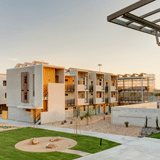On a completely flat, 4.2-acre parcel of silt devoid of trees just half a mile from the busiest international port of entry along the US-Mexico border is an unusual site, and one that will prove to be quite historical: the location of the first-ever net-zero public-housing community in the nation. In the intense sun and wind of the Chihuahuan Desert, the Housing Authority of the City of El Paso (HACEP) transformed a vacant, 46-unit lot into the Paisano Green Community, a 73-unit, net-zero community that uses zero fossil fuels. Gerald Cichon, CEO of HACEP, is optimistic that the project will receive its LEED Platinum certification and become Enterprise Green Community-certified.

Using passive solar strategies for the hot, arid site in El Paso, TX, Paisano will be so efficient that some residents will pay as little as $8 in utility bills per year.
Many of the Paisano Green Community’s requirements were dictated by the housing project’s funding sources, most notably the American Recovery and Reinvestment Act. This meant that all materials had to be sourced from US companies, and in order to meet the LEED Platinum standards, HACEP had to receive at least 80 points across the five main categories, plus an additional six points for Innovation in Design and four points for Regional Priority.
It wasn’t Cichon’s initial goal to achieve net-zero status; that didn’t occur until a full year after the project began, when the team realized that net zero was a possibility with just a small expansion to the budget. Once the team learned more, they wanted to do more. “Our standards became much more stringent as the project went forward,” Cichon says. “We were introduced to innovative technology and design solutions, many of which were literally hitting the market as our plans unfolded.”

Paisano’s colorful canopy wall uses perforated metal panels as a radiant barrier to protect west-facing walls and courtyards from intense sunlight.
In order to bring the Paisano Green Community to life, HACEP launched a national design competition and eventually chose Colorado’s Workshop8 to implement its plans. The primary strategy was to capitalize on El Paso’s greatest natural resource: the sun. El Paso gets 302 days of sunshine per year, making it an epicenter of solar energy generation. As a result, the Paisano Green Community is powered by 170 kilowatts of expandable on-site solar generation thanks to 640 solar panels produced by Siliken. The property also features two Xzeres 442SR wind turbines that each generate up to 10 kilowatts of electricity, making the total capacity of on-site generation 190 kilowatts.
Passive design was as important as ‘active’ renewable-energy systems. “While the on-site electricity generation captures most of the headlines, the real energy savings that will enable us to attain net-zero certification is through the airtight construction of the units,” Cichon says. “Four different insulation systems were used, along with high albedo roofs that reflect a larger portion of the sun’s energy rather than absorbing it into the material.”
To minimize solar gain during the summer and maximize it during the winter, solar orientation became crucial. The Paisano Green Community doesn’t have many east- or west-facing windows; all windows are positioned to the north and south. Because of all the technological and design strategies employed, some of the seniors who will live in the Paisano Green Community will pay as little as $8 per year in energy bills.

“Everyone who has been involved with this project has a great deal of passion and commitment because they know that projects such as the Paisano Green Community are redefining affordable housing in the United States,” says Gerald Cichon, CEO of the Housing Authority of the City of El Paso.
The community also utilizes mini-split air source heat pumps and energy recovery ventilators that bring in fresh air and capture the energy in the interior air before it is exhausted. These units are low-noise, and they reduce allergens and toxins and provide high-efficiency heating and cooling. Even more impressive, all connective spaces, such as hallways and stairwells, are open-air environments that don’t have to be heated, cooled, lit, or ventilated.
Another critical strategy for the success of the Paisano Green Community was to engage in net metering so that energy could be purchased at night from the grid at the same rate energy on the grid was sold during the day. Due to different billing structures for peak and off-peak rates, Cichon and his team tasked a local elected delegation to grant them an exemption under the Public Utility Commission; the exemption essentially allowed them to purchase and sell at the same rate.
“Affordable housing consumes significantly more energy per square foot than private housing,” Cichon says. “This not only pollutes the environment, but also puts an unfair burden on the millions of low-income households that sacrifice necessities such as food and medical care in order to meet monthly energy and rent payments. Everyone who has been involved with this project has a great deal of passion and commitment because they know that projects such as the Paisano Green Community are redefining affordable housing in the United States.”

